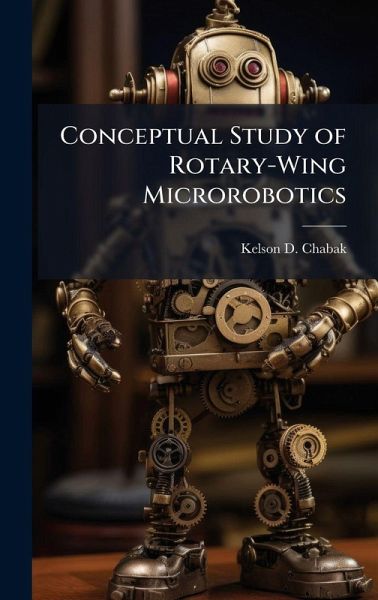
Conceptual Study of Rotary-Wing Microrobotics
Versandkostenfrei!
Versandfertig in über 4 Wochen
30,99 €
inkl. MwSt.
Weitere Ausgaben:

PAYBACK Punkte
15 °P sammeln!
This thesis presents a novel rotary-wing micro-electro-mechanical systems (MEMS) robot design. Two MEMS wing designs were designed, fabricated and tested including one that possesses features conducive to insect level aerodynamics. Two methods for fabricating an angled wing were also attempted with photoresist and CrystalBondTM to create an angle of attack. One particular design consisted of the wing designs mounted on a gear which are driven by MEMS actuators. MEMS comb drive actuators were analyzed, simulated and tested as a feasible drive system. The comb drive resonators were also designed...
This thesis presents a novel rotary-wing micro-electro-mechanical systems (MEMS) robot design. Two MEMS wing designs were designed, fabricated and tested including one that possesses features conducive to insect level aerodynamics. Two methods for fabricating an angled wing were also attempted with photoresist and CrystalBondTM to create an angle of attack. One particular design consisted of the wing designs mounted on a gear which are driven by MEMS actuators. MEMS comb drive actuators were analyzed, simulated and tested as a feasible drive system. The comb drive resonators were also designed orthogonally which successfully rotated a gear without wings. With wings attached to the gear, orthogonal MEMS thermal actuators demonstrated wing rotation with limited success. Multi-disciplinary theoretical expressions were formulated to account for necessary mechanical force, allowable mass for lift, and electrical power requirements. The robot design did not achieve flight, but the small pieces presented in this research with minor modifications are promising for a potential complete robot design under 1 cm2 wingspan. The complete robot design would work best in a symmetrical quad-rotor configuration for simpler maneuverability and control. The military's method to gather surveillance, reconnaissance and intelligence could be transformed given a MEMS rotary-wing robot's diminutive size and multi-role capabilities. This work has been selected by scholars as being culturally important, and is part of the knowledge base of civilization as we know it. This work was reproduced from the original artifact, and remains as true to the original work as possible. Therefore, you will see the original copyright references, library stamps (as most of these works have been housed in our most important libraries around the world), and other notations in the work. This work is in the public domain in the United States of America, and possibly other nations. Within the United States, you may freely copy and distribute this work, as no entity (individual or corporate) has a copyright on the body of the work. As a reproduction of a historical artifact, this work may contain missing or blurred pages, poor pictures, errant marks, etc. Scholars believe, and we concur, that this work is important enough to be preserved, reproduced, and made generally available to the public. We appreciate your support of the preservation process, and thank you for being an important part of keeping this knowledge alive and relevant.












